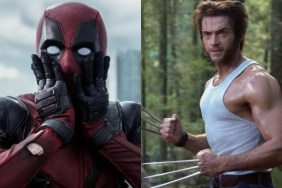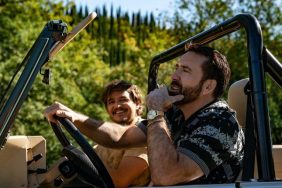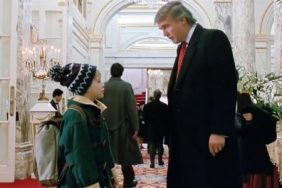I can think of no other film franchise that has attracted more scorn (sight unseen) and has inspired more mockery of the Hollywood machine than the 1997 family classic Air Bud. Audiences and film critics hounded this thing (pun intended) to no end, eliciting countless inappropriate comparisons. A common phrase I heard back in the late 1990s was “At least it wasn’t as bad as that movie about the dog that plays basketball.” This comment came most often from people who hadn’t seen Air Bud, but it was a legitimate complaint about the film’s farfetched premise. A real-life, non-animated, non-anthropomorphic dog who plays basketball? Bizarre. And while there are plenty of films with dumber setups (anything with a killer snowman gets my vote in this regard), Air Bud does, to this day, have a weird stigma attached to it. As if this was the nadir of toothless family entertainment.
Well, time heals all wounds, as they say, and I, your humble critic, have, in 2011, decided to see what all that hoopla was about, and willingly chose to sit down in front of the five Air Bud feature films to date, and dissect them in my Series Project to see how they flow together as a unit. I don’t take drugs, so this is the kind of thing I have to do to myself to get high. I watch an entire series of kids’ movies, and see what it does to me. Heck, if I can make it through ten Pokémon films, I can do five about a sports dog.
N.B. I decided to stop at five, as the sixth film in the series, Air Buddies (2006) is actually more of a spinoff series, wherein Bud’s litter of puppies, now all voiced by child actors, have their own adventures that have nothing to do with their father dog, or with sports. Perhaps someday I’ll feel brave enough to belly up to the five Air Buddies movies to date, although there are, according to the Internet Movie Database, three more currently in production; I’ll have to wait until Spy Buddies comes out in 2015 to give that series some serious thought. Plus, I’ll have to give some serious thought to whether or not I want to include the Santa Paws films which are a further Christmas-themed spinoff to the Air Buddies films. These movies are like cells, or those planaria flatworms you learned about in the 8th grade. They simply keep on dividing, asexually, into the cinematic firmament.
But onto Air Bud. There were five feature films about “Air” Bud, starting in 1997 and ending in 2003. In each film, the same dog, Buddy, plays a different sport, usually aided by his human master. Each film takes place in the same town of Fernfield, WA (which was clearly a small, perpetually overcast town in Canada), and follows the same human characters, most notably Josh Framm, played by Kevin Zegers, a cool-looking but somewhat bland kid who seems to shift interest in sports rather often. Later in the series, focus shifted to his little sister Andrea (played by various actresses). Josh was always played by the same actor, but his mother, stepfather, sister, little half-brother, and indeed the dog itself, all rotated cast members pretty much with every film. His stepfather in particular went through some pretty dramatic changes, which I’ll get to later. The series starts surprisingly strong, and vaguely saunters into a very particular brand of Disney pabulum that we’re all too familiar with.
The title, by the way – and this is for anyone too young to remember this – alludes to the popular brand of Nike sneakers endorsed by Michael Jordan called “Air Jordans,”first introduced in 1985, and hitting it particularly big in about 1994. The shoes were incredibly popular, largely thanks to the ad campaign to feature Jordan himself standing opposite film director Spike Lee, and cost hundreds of dollars in most show outlets. Kids my age probably remember the scandals in some high schools, as kids were literally committing murder to get their hands on a pair. There was a time when these basketball shoes were the hottest ticket it town. This also means that the basketball appellation of “Air Bud” to a dog that drifts increasingly away from basketball will make less and less sense as the films goes on.
To the first film.
AIR BUD (1997)
Directed by: Charles Martin Smith

The director, by the way, recently had a hit in theaters with Dolphin Tale. He’s also an actor you recognize from films like American Graffiti and John Carpenter’s Starman. He was also the guy from the 1983 Disney film Never Cry Wolf, which is one of those movies that I think everyone of a certain age managed to see, even if they didn’t try.
Air Bud is, as I indicated above, a surprisingly good movie (and, yes, I’m putting whatever critical reputation I have on the line in stating that). This is not to say that it’s a family classic, but for a film that is predicated on the notion of a basketball-playing dog, it’s rather emotionally sound, and is shot with a glittering professionalism that one would not expect. Most family films these days, especially those relegated to the straight-to-video market, seem to have the exact same brand of bright, even lighting that one usually sees on TV. Air Bud was shot by Mike Southon, who previously photographed films like Little Man Tate and Ken Russel’s drug-addled sex fantasy Gothic, so he has some professional oomph behind him. It’s curious, then, to learn that Southon also shot the proceeding chapters in the series, where the lighting became less interesting. Perhaps he lost passion for the material. But you’ll note, especially early in the film, just how gorgeous the movie looks.
Air Bud stars with our title dog, Buddy (Buddy), a friendly-faced golden retriever, who is in the employ of the abusive and creepy professional clown Norm Snively, played by the late Michael Jeter. Norm is seen in an early scene creeping out a birthday party full of children with his failed clown act. When he gets Buddy into the act, the kids react positively. Buddy is adept at catching balls in his mouth. When the birthday party inevitably explodes into a cacophony of flying cakes and screaming children (as children’s birthday parties so often do in movies), Norm is thrown out without pay. Norm, in anger, blames the dog. The dog is thrown haphazardly on the back of a pickup truck, where he eventually falls off, and escapes.
On the human side of the story, we have little Josh Framm, about 12 years old, who has just moved to Fernfield, WA with his mother (Wendy Makkena) and his infant sister (Jessebel and Kati Mather) in order to get over the recent death of his father. This is a curious and disturbing trend in anything Disney touches, and I’m certainly not the first critic to point it out, but families are often sans one parent at the outset. Go through the canonical Disney animated features and try to think of the films in which both parents were present. You’ll find that the number is much smaller than the film that feature widows and widowers. Josh, naturally, hates that he had to move, even though his house is huge. I seem to recall that he moved from Detroit, though, so maybe he just doesn’t like small-town life.
Josh spends extended periods wandering around town by himself. He is a basketball aficionado, but is not very good at the game, and his school coach (Stephen E. Miller) is kind of a sadistic d**khead. One afternoon, Josh finds an abandoned church with a disused basketball court next to a picturesque lake. It’s here that he meets Buddy, still wearing the ripped remnants of his clown outfit. Josh tries to pet Buddy, but eventually has to ply him, E.T. style, with sweets. Josh begins practicing basketball with Buddy, and learns that, by bouncing the ball at the dog, Buddy can boink it off his nose and, with great accuracy, into the basket. Josh thinks nothing of this, other than that it’s a neat trick. Josh eventually takes Buddy home to give him a bath.
Oh God, the bath scene. Yes, Bobby Darin’s famous “Splish Splash” plays over this montage. Yes, there’s the usual predictable “wacky” mess-making. I’ve never found the making of messes to be particularly funny. And, for some reason, Josh also decides to brush the dog’s teeth. It’s all pretty painful to watch. When mom gets home, Buddy accidentally sprints into the living room, knocking over a paint can (the house is still being painted). Despite this, Buddy is allowed to stay, so long as he stays in the backyard. Buddy, clever creature that he is, still manages to sneak in at night. Indeed, and here’s a bit of strangely solid continuity between all five movies: they were all shot at the same house, meaning Buddy’s trick of climbing on top of a car, onto the roof, and in through Josh’s second-story window, makes increasing sense as the films pass. Well, for as much sense as these films make.

Buddy follows Josh to school, and watches Josh play basketball. The school’s team, The Timberwolves, is not very good, and often get solidly trounced by their opponents. Here’s an interesting detail: the other kids on the team seem to all be named after famous filmmakers. There’s a Hawks, a Ford, a Huston I think, and a Fuller. I kept an eye out, but I saw no Hitchcocks, no Kurosawas, and no Herzogs. I suppose if you’re making a silly film about a basketball-playing dog, you put in whatever entertaining details you can in order to amuse yourself. Josh loses a lot of games, and becomes despondent, only kept emotionally afloat by Buddy. His mom, meanwhile, is considering dating again. Gulp. Josh also notices that the school’s kindly janitor, Mr. Chaney (Bill Cobbs) seems to have an inordinate interest in basketball. Hm…
There is a scene where, after losing a game, one of the kids is pelted with basketballs by his coach. It’s actually a dark and brutal scene than manages to lend weight to the proceedings. This is not child abuse as cheap gimmick. This is actual child abuse. The coach is fired, and Mr. Chaney, at Josh’s plea, becomes the new coach. Mr. Chaney teaches the kids to play without a ball, miming only, so they learn to make eye contact on the court. This actually seems like a viable strategy. If this movie had no basketball-playing dog in it, it would be a boilerplate sports film. Buddy, since he is always present, is made the mascot of the team, and, during halftime, displays his ability to make baskets. The citizens of Fernfield love him, and nickname him Air Bud.

Final big game. Must be one. Players get injured. Innocuously evil team threatens to defeat them all. Josh suggests Buddy be brought in. And, yes, we are given the clarion line of dialogue “Ain’t no rule says a dog can’t play basketball.” Buddy is given little sneakers, and, because he’s a dog, baffles the opposing team. The dog is damn cute, but watching his paw give high fives is a bit insufferable. Indeed, they win the game. All this happens in the film’s final 15 minutes, and I admire the filmmakers’ restraint in keeping the actual basketball playing dog stuff to the very end; they actually bothered to make a real movie around it. For this first film, that’s the curious balance: You want to make a hefty, emotional film, but you’re handicapped by the goofy-ass premise.
Then there’s an epilogue where Michael Jeter reappears, having seen all the local publicity, claiming Buddy as his own. In a weird, weird extension of the action, the clown man takes Josh and his mom to court over ownership of the dog. The judge, a Santa Claus-type, allows the dog to choose its owner. The entire town shows up for the trial. Buddy, of course, chooses Josh, even though returning to an abusive owner can be alluring (the abuse dynamics are disturbingly real). Triumphant music plays, and all is well.
I know some parents have to suffer through their young child’s favorite videos time and time again, however bad they might be. If your kid latches onto the first Air Bud film, you may not find yourself hurting too much, even after the fifth viewing. It’s professional, well paced, and seems to resemble the real world for much of its running time. The next film skews a bit stupid, sadly.
NEXT: And then things started to suck right away…
AIR BUD: GOLDEN RECEIVER (1998)
Directed by: Richard Martin

Now that they’ve won the championship, where do we go? The only logical progression is to another sport. Why does Josh turn his back on basketball and take up football? I dunno. He seems disillusioned with his old life, even though only a year has passed since the trial that the entire town of Fernfield, WA showed up for. Kevin Zegers, I should note here, is turning into a handsome young man. Zegers reminds me of those handsome classmates I used to have in jr. high school who could coast on charm, even though they had the brains to back themselves up. I felt oddly envious of Keven Zegers. His legacy may be dubious, but something tells me that the good-looking bastard takes it with good graces.
Anyway, Josh’s big dilemma in the last film was trying to learn to live without his father. In this film, his conflict is accepting him mom with a new man. His mom is now played by Cynthia Stevenson from Todd Solondz’s Happiness, and she’s pretty good at playing a mom. Andrea is now played by Alyson MacLaren. Mom’s new man is played by the blandly good-looking silver fox Gregory Harrison from Trapper John, M.D. The new man, Patrick, is also the town’s veterinarian, and is himself a widower. We’re going to be keeping an eye on this guy, as he’ll go through some weird mutations throughout the films.

I’m not sure what I can really say about Josh’s plot in this film. He takes up football. He’s okay at it. The Timberwolves are again on a losing streak until Josh and Buddy (now played by a quartet of new dogs, named Chase, Chance, Zak and Rush) raise their spirits. The team’s coach, Mr. Fanelli, is played by recognizable character actor Robert Costanzo, and, while fat, is not a goofy buffoon. Indeed, Mr. Fanelli has a few scenes with the school’s principal about the possible lack of future of the school’s athletic department. Sadly, it’s Mr. Fanelli who has to speak the film’s title aloud. “Dat dere’s no golden retriever,” he says, “Dat dere’s a golden receiver.” Groan. Yes, it’s not long before Buddy reveals that he can catch a football and run it to an end zone. While the film is still well shot, and they do manage to keep Buddy off the field for the bulk of the film, Golden Receiver naturally doesn’t have the same freshness, tilting toward – but not yet falling fully into – boring, well-lit Disney family pap.
Who would tackle a dog?
There are a few surreal things about this film, most glaring of which is the huge, time-wasting subplot. Lurking about Fernfield is a pair of failing Russian circus owners played by comedienne Nora Dunn and Perry Anzilotti. They speak with bad Russian accents that would make Boris and Natasha wince. They have a cadre of performing animals, including raccoons and monkeys. When they see that they live near Air Bud, they decide to kidnap him and force him to perform in the circus. The curious things about these scenes is that they were clearly shot at a different time from the rest of the movie. Dunn and Anzilotti never appear on camera with the other actors, and they even seem to be lit differently. They’re scenes are so tonally different from the human drama, that I suspected their entire story was tacked on in post I order to add some broad comic moments for the kiddies. The only connection the Russian subplot has to the rest of the film was a scene near the end when Buddy, finally slipped free of their clutches, is implored by Harrison (who is, for some reason, there) to rush to the central, final football game.

The other surreal thing was the celebrity cameos at the film’s game. The two football announcers were played by, get this…Tim Conway and Dick Martin. Yes, the guy from The Carol Burnett Show and the co-founder of Laugh-In, now aged, give color commentary for the final game. But they aren’t really allowed to riff. They give a few funny, clearly improvised lines of dialogue as if they’re going to begin to riff, but the film doesn’t let them finish. Seeing such famous comedy heavyweights in such a light and kind of bland movie is bizarre.
The innocuously evil team they must beat is outraged that a dog is allowed to play (oh yeah, did I forget to mention that Buddy is allowed in the game? He is). It’s curious that a word of a famous basketball-playing dog hasn’t reached their ears. Well, until one line of dialogue where a player reminds coach “Hey, that’s Air Bud.” The coach only then looks nervous. Fernfield seems to have a short memory. It was only a year ago that they were gathering, en masse, to clear Air Bud’s name in court. Now he’s just an institution. Oh well. Yes, the good guys win, and Josh comes to an understanding with Patrick. The evil Russians drive their van into a lake, and are apprehended by the police. All is well with the world.
Air Bud: Golden Receiver is the last shred of quality we may have had from this premise. The following films don’t get bed, necessarily, but they do become increasingly nondescript, as we shall see in Air Bud: World Pup.
You know what? I think that’s the most anyone has ever written about the Air Bud movies to date, and I still have three movies to go. Be sure to join me for the next chapter where I further explore how Patrick mutates, how the story becomes increasingly toothless, and how dull family entertainment tends to be without character. Also, so you can feel my pain, as I’m going to encounter a being in these movies that I hate more than Satan himself.
See you next week for Air Bud 3-5!








